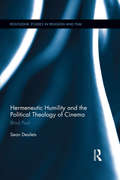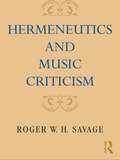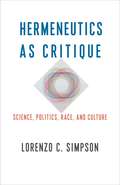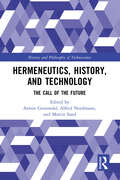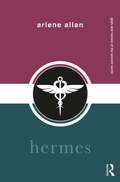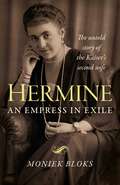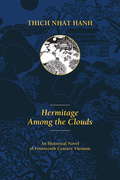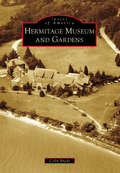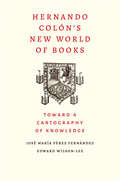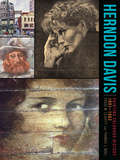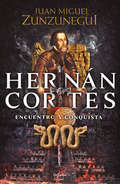- Table View
- List View
Hermeneutic Communism: From Heidegger to Marx (Insurrections: Critical Studies in Religion, Politics, and Culture)
by Gianni Vattimo Santiago ZabalaHaving lost much of its political clout and theoretical power, communism no longer represents an appealing alternative to capitalism. In its original Marxist formulation, communism promised an ideal of development, but only through a logic of war, and while a number of reformist governments still promote this ideology, their legitimacy has steadily declined since the fall of the Berlin wall. Separating communism from its metaphysical foundations, which include an abiding faith in the immutable laws of history and an almost holy conception of the proletariat, Gianni Vattimo and Santiago Zabala recast Marx's theories at a time when capitalism's metaphysical moorings—in technology, empire, and industrialization—are buckling. While Michael Hardt and Antonio Negri call for a return of the revolutionary left, Vattimo and Zabala fear this would lead only to more violence and failed political policy. Instead, they adopt an antifoundationalist stance drawn from the hermeneutic thought of Martin Heidegger, Jacques Derrida, and Richard Rorty.Hermeneutic communism leaves aside the ideal of development and the general call for revolution; it relies on interpretation rather than truth and proves more flexible in different contexts. Hermeneutic communism motivates a resistance to capitalism's inequalities yet intervenes against violence and authoritarianism by emphasizing the interpretative nature of truth. Paralleling Vattimo and Zabala's well-known work on the weakening of religion, Hermeneutic Communism realizes the fully transformational, politically effective potential of Marxist thought.
Hermeneutic Humility and the Political Theology of Cinema: Blind Paul (Routledge Studies in Religion and Film)
by Sean DesiletsThis book revisits the tradition of Western religious cinema in light of scholarship on St. Paul’s political theology. The book’s subtitle derives from the account in the Book of Acts that St. Paul was temporarily blinded in the wake of his conversion on the road to Damascus. In imitation of Paul, the films on which Sean Desilets’s analysis hinges (including those of Carl-Th. Dreyer, Robert Bresson, Pier Paolo Pasolini, and Carlos Reygadas) place a god-blind mechanism, the camera, between themselves and the divine. Desilets calls the posture they adopt "hermeneutic humility": hermeneutic in that it interprets the world, but humble in that it pays particular—even obsessive—attention to its own limits. Though these films may not consciously reflect Pauline theology, Desilets argues that they participate in a messianic-hermeneutic tradition that runs from Paul through St. Augustine, Blaise Pascal, Karl Barth, and Walter Benjamin, and which contributes significantly to contemporary discussions in poststructuralist literary theory, political theology, and religious studies. Desilets’s insightful explication of Jean-Luc Nancy’s deconstruction of Christianity and Georgio Agamben’s recent work on religion makes a substantial contribution to film philosophy and emerging critical trends in the study of religion and film. This book puts forward a nuanced theoretical framework that will be useful for film scholars, students of contemporary political theology, and scholars interested in the intersections of religion and media.
Hermeneutics and Music Criticism
by Roger W. SavageHermeneutics and Music Criticism forges new perspectives on aesthetics, politics and contemporary interpretive strategies. By advancing new insights into the roles judgment and imagination play both in our experiences of music and its critical interpretation, this book reevaluates our current understandings of music’s transformative power. The engagement with critical musicologists and philosophers, including Adorno, Gadamer, and Ricoeur, provides a nuanced analysis of the crucial issues affecting the theory and practice of music criticism. By challenging musical hermeneutics’ deployment as a means of deciphering social values and meanings, Hermeneutics and Music Criticism offers an answer to the long-standing question of how music’s expression of moods and feelings affects us and our relation to the world.
Hermeneutics as Critique: Science, Politics, Race, and Culture (New Directions in Critical Theory #72)
by Lorenzo C. SimpsonHermeneutics has frequently been dismissed as useful only for literary and textual analysis. Some consider it to be Eurocentric or inherently relativistic and thus unsuited to social critique. Lorenzo C. Simpson offers a persuasive and powerful argument that hermeneutics is a valuable tool not only for critical theory but also for robustly addressing many of the urgent issues of today.Simpson demonstrates that hermeneutics exhibits significant interpretive advantages compared to competing explanatory modalities. While it shares with pragmatism a suspicion of essentialism, an understanding that disagreements are situated, and an insistence on the dialogical nature of understanding, it nevertheless resolutely rejects the relativistic accounts of rationality that are often associated with pragmatism. In the tradition of Gadamer, Simpson firmly establishes hermeneutics as a resource for both philosophy and the social sciences. He shows its utility for unpacking intractable issues in the philosophy of science, multiculturalism, social epistemology, and racial and social justice in the global arena. Simpson addresses fraught questions such as why recent claims that “race” has a biological basis lack grounding, whether female genital excision can be critically addressed without invidious ethnocentrism, and how to lay the foundations for meaningful cross-cultural dialogue and reparative justice. This book reveals how hermeneutics can be a worthy partner with critical theory in achieving emancipatory aims.
Hermeneutics, History and Memory
by Philip GardnerHistory is the true record of an absent past. The trust between historians and their readers has always been founded upon this traditional claim. In a postmodern world, that claim and that trust have both been challenged as never before, drawing either angry or apologetic responses from historians. Hermeneutics, History and Memory answers differently. It sees the sceptical challenge as an opportunity for reflection on history’s key processes and practices, and draws upon methodological resources that are truly history’s own, but from which it has become estranged. In seeking to restore these resources, to return history to its roots, this book presents a novel contribution to topical academic debate, focusing principally upon: the challenges and detours of historical methodology hermeneutic interpretation in history the work of Paul Ricoeur the relation between history and memory. Hermeneutics, History and Memory will appeal to experienced historical researchers who seek to explore the theoretical and methodological foundations of their empirical investigations. It will also be highly beneficial to research students in history and the social sciences concerned with understanding the principles and practices through which documentary analysis and in-depth interview can be both validated and conducted.
Hermeneutics, History, and Technology: The Call of the Future (History and Philosophy of Technoscience)
by Alfred Nordmann Armin Grunwald Martin SandFor better and worse, the future is often conceived in technological terms. Technology is supposed to meet the challenge of climate change or resource depletion. And when one asks about the world in 20 or 100 years, answers typically revolve around AI, genome editing, or geoengineering. There is great demand to speculate about the future of work, the future of mobility, Industry 4.0, and Humanity 2.0. The humanities and social sciences, science studies, and technology assessment respond to this demand but need to seek out a responsible way of taking the future into account. This collection of papers, interviews, debates grew out of disagreements about technological futures, speculative ethics, plausible scenarios, anticipatory governance, and proactionary and precautionary approaches. It proposes Hermeneutic Technology Assessment as a way of understanding ourselves through our ways of envisioning the future. At the same time, a hermeneutic understanding of technological projects and prototypes allows for normative assessments of their promises. Is the future an object of design? This question can bring together and divide policy makers, STS scholars, social theorists, and philosophers of history, and it will interest also the scientists and engineers who labor under the demand to deliver that future.
Hermes (Gods and Heroes of the Ancient World)
by Arlene AllanHermes redresses the gap in modern English scholarship on this fascinating and complex god, presenting its readers with an introduction to Hermes’ social, religious and political importance through discussions of his myths, iconography and worship. It also brings together in one place an integrated survey of his reception and interpretation in contemporaneous neighbouring cultures in antiquity as well as discussion of his reception in the post-classical periods up to the present day. This volume is an invaluable resource for anyone wanting to explore the many facets of Hermes’ myth, worship and reception.
Hermes The Thief: The Evolution of a Myth
by Norman Oliver BrownHermes is a vital and complex figure in Greek mythology—trickster and culture hero, divine child and patron of stealthy action, master of magic words, seducer and whisperer. Shepherd, artisan, herald, musician, athlete, merchant—who is this tricky shape-shifter, confronting us at every turn?In this classic, prescient work…Brown asks: Is Hermes the Thief the prototype from which, by extension and analogy, the Trickster was derived? Alternatively, is the notion of trickery the fundamental idea and theft merely a specific manifestation of it?This thoughtful study will be of interest to anyone wishing a fresh view of an important, often misunderstood, character of Greek mythology.-Print ed.
Hermetica II: The Excerpts of Stobaeus, Papyrus Fragments, and Ancient Testimonies in an English Translation with Notes and Introduction
by M. David LitwaThis volume presents in new English translations the scattered fragments and testimonies regarding Hermes Thrice Great that complete Brian Copenhaver's translation of the Hermetica (Cambridge, 1992). It contains the twenty-nine fragments from Stobaeus (including the famous Kore Kosmou), the Oxford and Vienna fragments (never before translated), an expanded selection of fragments from various authors (including Zosimus of Panopolis, Augustine, and Albert the Great), and testimonies about Hermes from thirty-eight authors (including Cicero, Pseudo-Manetho, the Emperor Julian, Al-Kindī, Michael Psellus, the Emerald Tablet, and Nicholas of Cusa). All translations are accompanied by introductions and notes which cite sources for further reading. These Hermetic texts will appeal to a broad array of readers interested in western esotericism including scholars of Egyptology, the New Testament, the classical world, Byzantium, medieval Islam, the Latin Middle Ages, and the Renaissance.
Hermetica: The Greek Corpus Hermeticum and the Latin Asclepius in a new English translation, with notes and introduction
by Brian P. CopenhaverThe Hermetica are a body of theological-philosophical texts written in late antiquity, but long believed to be much older. Their supposed author, Hermes Trismegistus, was thought to be a contemporary of Moses, and the Hermetic philosophy was regarded as an ancient theology, parallel to the received wisdom of the Bible. This first English translation based on reliable texts, together with Brian P. Copenhaver's comprehensive introduction, provide an indispensable resource to scholars in ancient philosophy and religion, early Christianity, Renaissance literature, and history, the history of science, and the occultist tradition in which the Hermetica have become canonical texts.
Hermine: The Untold Story of the Kaiser's Second Wife
by Moniek BloksHermine Reuss of Greiz is perhaps better known as the second wife of the Kaiser (Emperor Wilhelm II of Germany) whom she married shortly after the death of his first wife Auguste Viktoria and while he was in exile in the Netherlands. She was by then a widow herself with young children. She was known to be ambitious about wanting to return to power, and her husband insisted on her being called 'Empress'. To achieve her goal, she turned to the most powerful man in Germany at the time, Adolf Hitler. Unfortunately, her dream was not realised as Hitler refused to restore the monarchy and with the death of Wilhelm in 1941, Hermine was forced to return to her first husband's lands. She was arrested shortly after the end of the Second World War and would die under mysterious circumstances while under house arrest by the Red Army.
Hermitage Among the Clouds: An Historical Novel of Fourteenth Century Vietnam
by Annabel Laity Mobi WarrenHermitage Among the Clouds tells the story of the fourteenth century Princess Amazing Jewel, the daughter of one of Vietnam's greatest historical Zen master kings. This beautifully written story expreses the suffering caused by war and conflict, the transformative potential of a commitment to practicing peace and building reconciliation, and the simple beauty of a spiritual life. Thich Nhat Hanh gives us a window into Vietnam's past and at the same time, offers compelling insights about contemporary Southeast Asia and the world.
Hermitage Museum and Gardens (Images of America)
by Colin BradyIn 1907, William and Florence Sloane began construction on a five-room summer cottage on the banks of the Lafayette River in Norfolk. Over the course of 30 years, they would expand their home from its origins as a summer retreat into a 42-room Arts and Crafts mansion nestled on 12 acres of gardens and grounds. As their home grew, so did their desire to bring an arts scene to southeastern Virginia. In 1937, the Sloanes turned their attention to repurposing their home as a museum. By opening the site to the public, the Sloane family created a new space for the arts and education in Norfolk. Today, visitors continue to enjoy their vision through an expansive art collection and acres of gardens and grounds.
Hermits: The Insights of Solitude
by Peter FranceOurs is an age where solitude tends to be discussed in the context of the 'problem of loneliness'. However in previous ages the capacity to seek fulfillment outside society has been admired and seen as a measure of discernment and inner security. In this lucid and highly readable book, Peter France shows how hermits, from the Taoists and Ancient Greeks to the present day, have something vitally important to say to a society that fears solitude.
Hermogenes' On Types of Style
by Cecil W. WootenCecil Wooten has produced the first translation into any modern langauage of a key treatise of the ancient world. He provides a faithful English translation of Hermogenes' analysis based on a reliable Greek text established by Rabe at the beginning of this century and includes a substantial scholarly introduction and notes that will help the reader better understand Hermogenes, his exposition, and the historical and cultural context in which it was produced. Hermogenes' work is both systematic and complex. He outlines, with almost mathematical precision, seven basic types of ideal forms of style -- Clarity, Grandeur, Beauty, Rapidity, Character, Sincerity, and Force -- some of which he breaks down into subtypes. Wooten explains how the stylistic system works, what it has in common with other systems developed in antiquity, and the special problems it presents to the translator.Wooten also provides two short essays. The first compares the system of stylistic analysis developed by Hermogenes with those of earlier critics, in particular Cicero and Dionysius of Halicarnassus. A single passage of Demosthenes is analyzed according to these three systems in order to illustrate how Hermogenes' system best captures its subtleties and nuances. The second essay discusses Hermogenes' concept of panegyric oratory and how it relates to the larger problem of secondary rhetoric. This translation makes On Types of Style accessible to classicists as well as Byzantinists, students and scholars of the Renaissance, rhetoricians, and, more broadly, students of literary criticism at any level.Originally published in 1987.A UNC Press Enduring Edition -- UNC Press Enduring Editions use the latest in digital technology to make available again books from our distinguished backlist that were previously out of print. These editions are published unaltered from the original, and are presented in affordable paperback formats, bringing readers both historical and cultural value.
Hernan Cortes - Letters from Mexico
by Anthony Pagden Hernán CortésWritten over a seven-year period to Charles V of Spain, Hernan Cortes' letters provide a narrative account of the conquest of Mexico from the founding of the coastal town of Veracruz until Cortes's journey to Honduras in 1525.
Hernando Colon's New World of Books: Toward a Cartography of Knowledge
by Edward Wilson-Lee Jose Maria Perez FernandezThe untold story of the greatest library of the Renaissance and its creator Hernando Colón This engaging book offers the first comprehensive account of the extraordinary projects of Hernando Colón, son of Christopher Columbus, which culminated in the creation of the greatest library of the Renaissance, with ambitions to be universal––that is, to bring together copies of every book, on every subject and in every language. Pérez Fernández and Wilson‑Lee situate Hernando&’s projects within the rapidly changing landscape of early modern knowledge, providing a concise history of the collection of information and the origins of public libraries, examining the challenges he faced and the solutions he devised. The two authors combine &“meticulous research with deep and original thought,&” shedding light on the history of libraries and the organization of knowledge. The result is an essential reference text for scholars of the early modern period, and for anyone interested in the expansion and dissemination of information and knowledge.
Hernando de los Ríos Coronel and the Spanish Philippines in the Golden Age
by John Newsome CrossleyWhilst much scholarly work has been focused on Spain's American colonies, much less is known about Spanish colonization of the Pacific. As such, this book fills an important gap in our knowledge, directing attention both to Spain's wider imperial ambitions, and the specific situation within the Philippines. By structuring the book around the life of Hernando de los RÃos Coronel, many overlapping and complex threads are drawn out that cast light upon a diverse range of subjects. Soldier, priest, diplomat, explorer, naval pilot and scientist, de los RÃos was a fascinating figure who played a pivotal role in Spanish efforts to establish a thriving colony in the Philippines. In 1588, at the age of 29 he was sent to the Philippines as a soldier, and once there quickly established himself as a pillar of society, ultimately becoming a priest. Over 36 years, until his death sometime before the end of January 1624, he shuttled between the Philippines and Spain, in his role as Procurator General - the sole representative of the Philippines (both Spaniards and Indigenes) at the Spanish Court. As well as telling the story of an extraordinary individual, this book provides a fascinating introduction to the early history of the Spanish Philippines. By touching upon a broad range of topics, it also opens up numerous avenues for further research.
Herndon Davis
by Thomas J. Noel Craig Leavitt"Herndon Davis, an artist and journalist, dedicated his life to depicting the major landmarks and personalities of Colorado in watercolor, oil, pen, and pencil. Best known for the Face on the Barroom Floor, the portrait of an alluring woman on the floor of the Teller House Hotel barroom in Central City, Colorado, Davis was a prolific artist whose murals, sketches, and portraits can be found all over the state, from the Sage Room of the Oxford Hotel on Seventeenth Street to the Denver Press Club poker room. Despite his numerous contributions, his work was never showcased or exhibited in the traditional manner.In this biography and first-ever collection featuring most of his life's work, authors Craig Leavitt and Thomas J. Noel provide a detailed look into Davis's life and career and include a catalog of almost 200 photographs of his work from Colorado and around the country. They also put his work into the broader context of the time through comparison with such contemporary Colorado artists as Muriel Sibell Wolle, Allen Tupper True, Charles Waldo Love, and Juan Menchaca.Published to coincide with the Denver Public Library's 2016 exhibition--the only public display of Davis's work to date--and bringing deserved attention to this overlooked figure, Herndon Davis: Painting Colorado History, 1901-1962 is an important contribution to Colorado's cultural history.This book and the accompanying exhibit are sponsored by the Western History/Genealogy Department at the Denver Public Library. Publication originated and supported in part by Diane B. Wunnike."
Herndon Davis: Painting Colorado History, 1901–1962
by Thomas J. Noel Craig LeavittHerndon Davis, an artist and journalist, dedicated his life to depicting the major landmarks and personalities of Colorado in watercolor, oil, and pen and pencil. Best known for the Face on the Barroom Floor, the portrait of an alluring woman on the floor of the Teller House Hotel barroom in Central City, Colorado, Davis was a prolific artist whose murals, sketches, and portraits can be found all over the state, from the Sage Room of the Oxford Hotel on Seventeenth Street to the Denver Press Club poker room. Despite his numerous contributions, his work was never showcased or exhibited in the traditional manner. In this biography and first-ever collection featuring most of his life’s work, authors Craig Leavitt and Thomas J. Noel provide a detailed look into Davis’s life and career and include a catalog of almost 200 photographs of his work from Colorado and around the country. They also put his work into the broader context of the time through comparison with such contemporary Colorado artists as Muriel Sibell Wolle, Allen Tupper True, Charles Waldo Love, and Juan Menchaca. Published to coincide with the Denver Public Library’s 2016 exhibition—the only public display of Davis’s work to date—and bringing deserved attention to this overlooked figure, Herndon Davis: Painting Colorado History, 1901-1962 is an important contribution to Colorado’s cultural history. This book and the accompanying exhibit are sponsored by the Western History/Genealogy Department at the Denver Public Library. Publication originated and supported in part by Diane B. Wunnike.
Herndon on Lincoln: Letters
by Douglas L. Wilson Rodney O. Davis William H. HerndonAfter Abraham Lincoln's assassination in 1865, William H. Herndon began work on a brief, "subjective" biography of his former law partner, but his research turned up such unexpected and often startling information that it became a lifelong obsession. The biography finally published in 1889, Herndon's Lincoln, was a collaboration with Jesse W. Weik in which Herndon provided the materials and Weik did almost all the writing. For this reason, and because so much of what Herndon had to say about Lincoln was not included in the biography, David Donald has observed, "To understand Herndon's own rather peculiar approach to Lincoln biography, one must go back to his letters." An exhaustive collection of what Herndon was told by others about Lincoln was published by Douglas L. Wilson and Rodney O. Davis in Herndon's Informants: Letters, Interviews, and Statements about Abraham Lincoln . In this new volume, Wilson and Davis have produced a comprehensive edition of what Herndon himself wrote about Lincoln in his own letters. Because of Herndon's close association with Lincoln, his intimate acquaintance with his partner's legal and political careers, and because he sought out informants who knew Lincoln and preserved information that might otherwise have been lost, his letters have become an indispensable resource for Lincoln biography. Unfiltered by a collaborator and rendered in Herndon's own distinctive voice, these letters constitute a matchless trove of primary source material. Herndon on Lincoln: Letters is a must for libraries, research institutions, and students of a towering American figure and his times.
Hernán Cortés. La verdadera historia (Historia Incógnita)
by Antonio CorderoHace 500 años España llega a México e impone, entre muchas otras cuestiones, lengua, gobierno y religión. ¿Qué era México antes de la llegada de los españoles? ¿Cortés destruyó una maravillosa civilización? ¿Por qué en el imaginario colectivo al conquistador se lo considera un militar cruel? ¿Qué habría pasado si los europeos no hubiesen llegado a América? En este libro Antonio Cordero analiza todas estas cuestiones de forma directa.
Hernán Cortés: Encuentro y conquista
by Juan Miguel ZunzuneguiHernán Cortés y Motecuzoma protagonizaron el choque de culturas más trascendente de la historia de la humanidad. Todo en la historia del mundo moderno es producto de ese encuentro y esa conquista. "Toda nuestra historia se integra en Hernán Cortés. Odiarlo no nos ha servido y no ha resuelto nada. Amarlo no es necesario. Aceptarlo e integrarlo en nuestro pasado, como el ser humano que es, con aciertos y fracasos, luces y sombras, es fundamental. No es ángel o demonio. Es simplemente Hernán Cortés, el hombre sin el cual no seríamos lo que somos." Juan Miguel Zunzunegui aborda la figura de Hernán Cortés y el acontecimiento de la conquista desde una perspectiva crítica y polémica: rechaza la idea maniquea de los buenos y los malos; desmonta el mito de un Hernán Cortés saqueador, asesino y destructor, frente a un Cortés culto, amante del mestizaje y del sincretismo; sitúa el evento de la conquista en un contexto mundial, que mucho tiene que ver con la historia de Europa y Oriente; y rastrea los lazos y las coincidencias entre las culturas religiosas indígena y cristiana, en un apasionante relato místico sobre México.
Hero Found: The Greatest POW Escape of the Vietnam War
by Bruce HendersonFrom the New York Times bestselling author of Sons and Soldiers comes the incredible but true story of Dieter Dengler, the only pilot to escape captivity from a POW camp in the Laotian jungle during the Vietnam War. In February 1966, Dieter Dengler was shot down over "neutral" Laos in jungle territory controlled by Pathet Lao guerrillas and North Vietnamese regulars, who captured and held him in a fortified prisoner-of-war camp. Already a legend in the navy for his unique escape skills, the German-born Dengler proved to be no ordinary prisoner. Caught in a desperate situation, imprisoned by the enemy and by the jungle itself, Dengler set out to free not only himself but also other POWs—American, Thai, and Chinese—some of whom had been held for years.This amazing story of triumph over seemingly insurmountable odds has been filmed by Werner Herzog as both a documentary (Little Dieter Needs to Fly) and a motion picture (Rescue Dawn, starring Christian Bale). Now Bruce Henderson, who served with Dengler aboard USS Ranger, tells the complete story of Dengler's captivity and remarkable escape—based on in-depth personal interviews as well as military archival materials, some never before made public—in this riveting account of unending optimism, courage, loyalty, and survival against overwhelming odds.
Hero Living: Seven Strides to Awaken Your Infinite Power
by Rudy ReyesIn Hero Living Rudy Reyes, the latest recruit in Channel 4's smash-hit SAS Who Dares Wins introduces his philosophy to life - part Homer, part Bruce Lee and part Spider-Man. He outlines various stages towards revealing your inner hero: recognising the hero's call, following the hero's path and returning from life's battlefield with the hero's hard-earned wisdom.Taking readers step-by-step through his tried and tested program, Rudy draws from his own heroic story of how he triumphed over harrowing childhood experiences of poverty and abandonment. Rather than giving up hope, he heeded the hero's call to live up to his full potential - first as a martial-arts champion, then as an elite warrior in the mountains of Afghanistan and on the sands of Iraq and finally in his post-Marines life as a personal trainer, actor, motivational speaker and now TV star.

